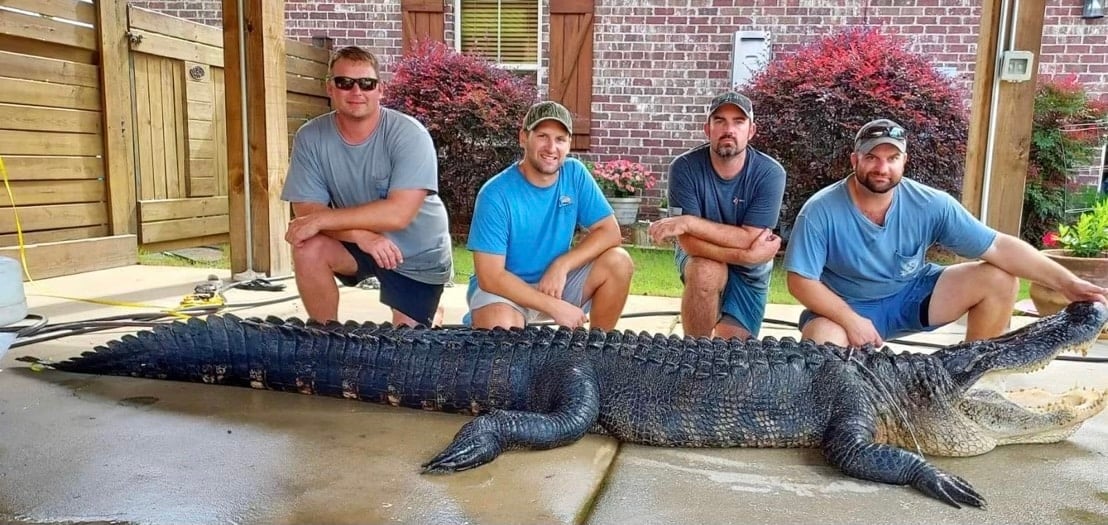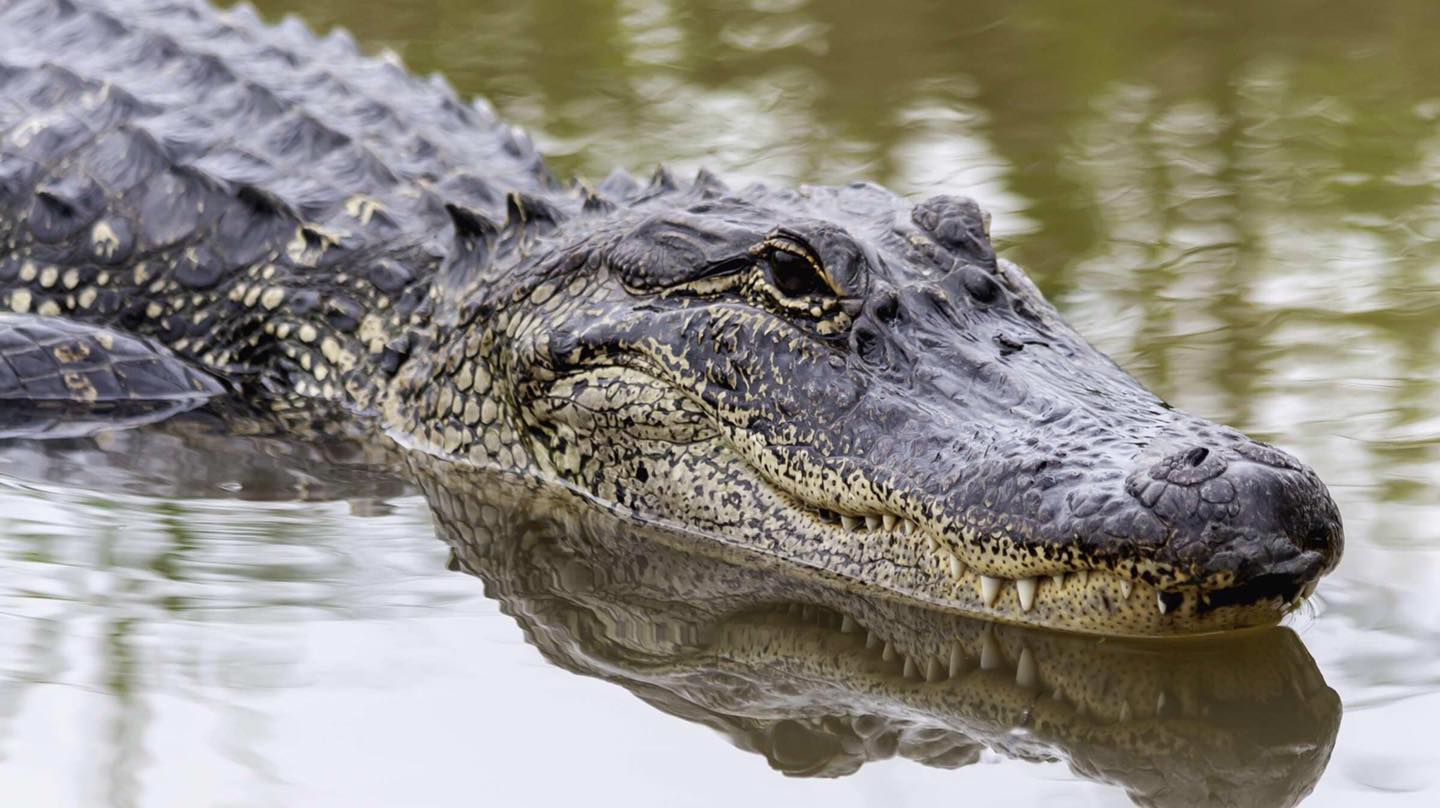SPANISH FORT, Ala. (CN) — Matt Burnett won the lottery this year, but he didn’t receive a financial windfall. Instead, he won heartbreak for a night. But only for a night. Then it paid off.
Earlier this summer, Burnett was one of only 260 Alabamians selected to participate in the 2022 alligator hunting season. When the season opened the evening of Aug. 11, Burnett and a crew of three friends hopped on a bass boat and followed a recommendation to stalk alligators around the mouth of Magnolia River in Baldwin County.
Only 50 tags were awarded in Alabama’s coastal zone, encompassing areas south of Interstate 10. Burnett and his crew had a window of two weekends to fill the tag, but the hunt was also regulated to occur only in the overnight hours. Hunters can’t capture an animal after the sun rises.
That first night, it was raining, Burnett said. Nevertheless, using spotlights and a silent trolling motor, his crew identified a target alligator, hooked it and spent hours bringing it alongside the boat. Then it got free.
“We were wet, tired and cold, and the check station was going to close before we could try it again, so we decided to pack up and come back Friday,” Burnett recalled this week. The following evening the crew returned, but chose to pick up the hunt a few miles north, just upstream from the mouth of Fish River.
Again, they pulled out the spotlights and quickly identified another large alligator. Only it had spotted them first and began to swim away. The hunters inched the boat forward, keeping the alligator's reflective eyes in their spotlight, until they could use an offshore spinning reel to throw a weighted treble hook across the animal's body, and pierce its thick hide with a barb.
“When we hooked into him, we had no idea how big he was,” Burnett said. “In our minds, we were settling on a smaller alligator. We thought he was probably 9-10 feet.”
Immediately and frequently over the next several hours, the alligator submerged, then would momentarily bring its eyes and nostrils to the surface to breathe. Once they had a clear shot, the anglers pierced the alligator with a second barb, this one fired from a crossbow. They began to slowly draw it closer to the boat, where they eventually secured it with a snare.
After it relaxed, the alligator was dispatched with a single shotgun blast to the brain stem. It took the effort of all four men onboard to heave the carcass on deck. At the check station, it weighed in at 602 pounds and measured 12 feet, nine inches.
“It was a massive, male alligator,” Burnett said.

American alligators, apex predators with a fossil record tracing back more than 65 million years, were listed as an endangered species in 1967 after native populations had been decimated by unregulated hunting and habitat degradation. Federal protections allowed the species to recover. By 1987, it was removed from endangered status and listed as threatened.
Chris Nix is the alligator program coordinator and District 5 supervisor at the Alabama Department of Conservation and Natural Resources who manages the check station where Burnett weighed in. Nix said Alabama has conducted limited hunts since 2006, although the number of tags has increased in recent years.
“We do population surveys in each zone and look at trends over an extended period of time to monitor those populations. That information also dictates our tag numbers,” Nix said.
The state received roughly 5,000 applications for the 260 tags this year, with recipients chosen at random by a computer program, one which also assigns “preference points” to hunters who have not been selected before. The application fee is $22. Burnett also received a tag in 2021, but it was for the Southwest zone, which includes the entirety of the Mobile-Tensaw River Delta north of Interstate 10. Last year, he weighed in an eight-foot, 140-pound female gator.
The state collects information including the animal’s weight, sex, length, body girth and tail girth. Then it exchanges the state tag for a federal tag, which will accompany the animal throughout processing. Similar alligator hunting seasons are opening this month in Florida, Georgia, Mississippi and Louisiana. Nix said it speaks volumes to the species’ recovery.
“It's really been a remarkable success story since they received federal protections,” he said. “It’s the reason we can have these hunts, but we still have to be cautious.”
For example, Nix said Alabama’s recent data suggested the alligator population in Lake Eufaula, on the Georgia border, had taken a dive. In response, the state reduced the number of tags awarded in the region during the annual hunt while it also imposed a minimum size restriction of the alligators that can be harvested there.
“If I go out and mess up a deer population, I can fix that population over two or three years through different regulations,” Nix explained. “But if I did the same thing to an alligator population, it may take a decade or two to bounce back. You can't manage them the same way from a reproductive or survivability standpoint, so that’s why we limit the tags.”
The only other federally protected species tagged in Alabama for limited hunts are the bobcat and the otter. Nix said the alligator hunts have proven popular and successful, and only a handful of citations have been issued for improperly dispatching the animals, improperly tagging the animals or bringing in undersized specimens.
Throughout the rest of the year Nix said he responds to a “tremendous” amount of nuisance alligator reports from the public, but the mere presence of an alligator can be unsettling to some, even if a sighting doesn’t constitute a nuisance.
"We have had such an influx of population growth down here over the last decade or so and it causes a lot more human/wildlife conflict,” Nix said. “Seventy percent of these calls are resolved by just educating people on how to live with alligators. But if an alligator is putting an immediate threat on human safety, pet safety or livestock safety, or if it’s in an area where it should not be, we either have to relocate it or euthanize it. You can’t change their learned behaviors.”
While fatal alligator attacks have been recorded in Florida, South Carolina and Louisiana in recent years, alligator attacks on humans remain exceedingly rare. Nix said he was not aware of any notable alligator attacks in Alabama, although some people have been bitten as a consequence of attempting to handle alligators.
Burnett said he has a great amount of respect for the recovering species, noting his catch this year was probably more than 30 years old, and its primary habitat was a small pocket of undeveloped marshland surrounded by waterfront homes and crisscrossed by voluminous recreational boat traffic every weekend.
“These animals are smart and have adapted to humans and what we’ve done to their ecosystem,” Burnett said. “But I don’t want people to fear them. We can coexist.”
Subscribe to Closing Arguments
Sign up for new weekly newsletter Closing Arguments to get the latest about ongoing trials, major litigation and hot cases and rulings in courthouses around the U.S. and the world.









